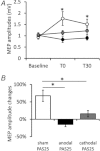Cerebellar modulation of human associative plasticity
- PMID: 22473780
- PMCID: PMC3424758
- DOI: 10.1113/jphysiol.2012.230540
Cerebellar modulation of human associative plasticity
Abstract
Paired associative stimulation (PAS) is a method commonly used in human studies of motor cortex synaptic plasticity. It involves repeated pairs of electrical stimuli to the median nerve and transcranial magnetic stimulation (TMS) of the motor cortex. If the interval between peripheral and TMS stimulation is around 21–25 ms, corticospinal excitability is increased for the following 30–60 min via a long term potentiation (LTP)-like effect within the primary motor cortex. Previous work has shown that PAS depends on the present and previous levels of activity in cortex, and that it can be modified by motor learning or attention. Here we show that simultaneous transcranial direct current stimulation (TDCS; 2 mA) over the cerebellum can abolish the PAS effect entirely. Surprisingly, the effect is seen when the PAS interval is 25 ms but not when it is 21.5 ms. There are two implications from this work. First, the cerebellum influences PAS effects in motor cortex; second, LTP-like effects of PAS have at least two different mechanisms. The results are relevant for interpretation of pathological changes that have been reported in response to PAS in people with movement disorders and to changes in healthy individuals following exercise or other interventions.
Figures



Similar articles
-
The Effect of Cerebellar Degeneration on Human Sensori-motor Plasticity.Brain Stimul. 2015 Nov-Dec;8(6):1144-50. doi: 10.1016/j.brs.2015.05.012. Epub 2015 Jun 16. Brain Stimul. 2015. PMID: 26140957
-
Interaction between different interneuron networks involved in human associative plasticity.Brain Stimul. 2014 Sep-Oct;7(5):658-64. doi: 10.1016/j.brs.2014.05.010. Epub 2014 Jun 8. Brain Stimul. 2014. PMID: 25103026 Clinical Trial.
-
Effect of Paired Associative Stimulation on Motor Cortex Excitability in Rats.Curr Med Sci. 2018 Oct;38(5):903-909. doi: 10.1007/s11596-018-1960-8. Epub 2018 Oct 20. Curr Med Sci. 2018. PMID: 30341527
-
Paired associative stimulation.Suppl Clin Neurophysiol. 2004;57:563-9. Suppl Clin Neurophysiol. 2004. PMID: 16106657 Review.
-
Transcranial cerebellar direct current stimulation (tcDCS): motor control, cognition, learning and emotions.Neuroimage. 2014 Jan 15;85 Pt 3:918-23. doi: 10.1016/j.neuroimage.2013.04.122. Epub 2013 May 9. Neuroimage. 2014. PMID: 23664951 Review.
Cited by
-
Differential modulation of motor cortex plasticity in skill- and endurance-trained athletes.Eur J Appl Physiol. 2015 May;115(5):1107-15. doi: 10.1007/s00421-014-3092-6. Epub 2014 Dec 31. Eur J Appl Physiol. 2015. PMID: 25549788
-
Neurophysiological markers of motor compensatory mechanisms in early Parkinson's disease.Brain. 2024 Nov 4;147(11):3714-3726. doi: 10.1093/brain/awae210. Brain. 2024. PMID: 39189320 Free PMC article.
-
Cerebellar Non-Invasive Brain Stimulation: A Frontier in Chronic Pain Therapy.J Pers Med. 2024 Jun 23;14(7):675. doi: 10.3390/jpm14070675. J Pers Med. 2024. PMID: 39063929 Free PMC article. Review.
-
Specific sensorimotor interneuron circuits are sensitive to cerebellar-attention interactions.Front Hum Neurosci. 2022 Aug 19;16:920526. doi: 10.3389/fnhum.2022.920526. eCollection 2022. Front Hum Neurosci. 2022. PMID: 36061499 Free PMC article.
-
Cerebellar transcranial direct current stimulation in neurological disease.Cerebellum Ataxias. 2016 Sep 2;3(1):16. doi: 10.1186/s40673-016-0054-2. eCollection 2016. Cerebellum Ataxias. 2016. PMID: 27595007 Free PMC article. Review.
References
-
- Antal A, Terney D, Poreisz C, Paulus W. Towards unravelling task-related modulations of neuroplastic changes induced in the human motor cortex. Eur J Neurosci. 2007;26:2687–2691. - PubMed
-
- Crupi D, Ghilardi MF, Mosiello C, Di Rocco A, Quartarone A, Battaglia F. Cortical and brainstem LTP-like plasticity in Huntington's disease. Brain Res Bull. 2008;75:107–114. - PubMed
-
- Dan Y, Poo MM. Spike timing-dependent plasticity: from synapse to perception. Physiol Rev. 2006;86:1033–1048. - PubMed
Publication types
MeSH terms
LinkOut - more resources
Full Text Sources
Medical

